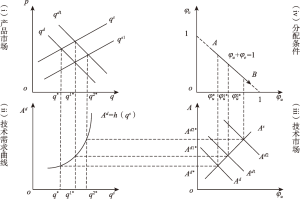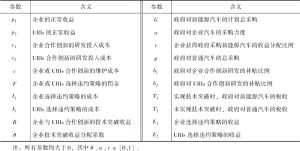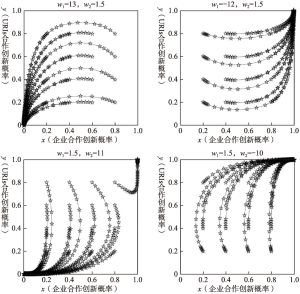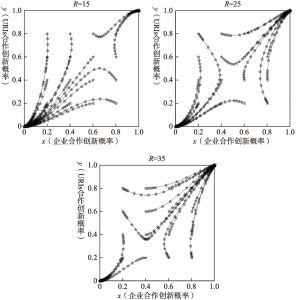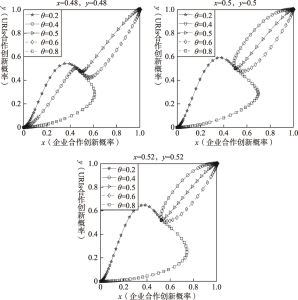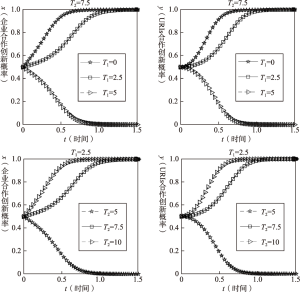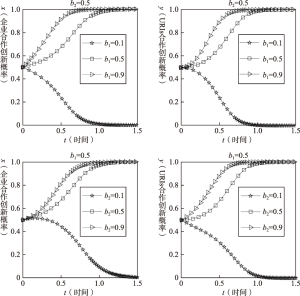摘要
鼓励与支持新能源汽车产业合作创新是促进节能减排的战略性举措。本文基于演化博弈模型,利用比较静态与仿真模拟方法分析了产学研成本收益和政府干预对新能源汽车产业合作创新演化的影响。(1)技术突破收益分配系数与政府采购收益分配系数在产学研合作创新中具有决定性影响,对产学研合作创新策略的选择具有非线性效应。(2)企业(学研即URIs)的成本收益参数通过改变新能源汽车产品(技术)市场的供给曲线,调整企业(URIs)对新能源汽车的技术需求(供给),并对新能源汽车技术市场的需求(供给)产生冲击,导致创新主体的分配条件发生变化。当企业分配条件降低,URIs分配条件提高时,产学研更可能形成合作创新。(3)政府干预主要通过影响新能源汽车产品市场和技术市场的供给函数,改变创新主体间的分配条件,以此推动产学研合作创新实现。(4)合作创新机会成本、维护成本、研发投入成本的上升抑制了产学研合作创新;技术突破收益、研发补贴增加和税收优惠政策以及新能源公车采购有利于产学研合作创新形成。最后,本文为推动新能源汽车产业政产学研合作创新实现提出了政策建议。
作者
贾凯威 (1980- ),男,博士,辽宁工程技术大学工商管理学院副教授,研究方向为风险管理与投资决策。
王高亮 (1996- ),男,辽宁工程技术大学产业经济学专业硕士研究生,研究方向为产业组织与政策。
- 曹霞,李传云,于娟,于兵.2020.市场机制和政府调控下的产学研合作创新网络演化博弈仿真——以新能源汽车产业为例[J].系统管理学报,29(3):464-474.
- 曹霞,邢泽宇,张路蓬.2018a.基于政府驱动的新能源汽车产业合作创新演化博弈研究[J].运筹与管理,27(6):21-30.
- 曹霞,邢泽宇,张路蓬.2018b.政府规制下新能源汽车产业发展的演化博弈分析[J].管理评论,30(9):82-96.
- 陈洪转,齐慧娟.2019.新能源汽车财政补贴政策监管演化稳定性分析[J].工业技术经济,38(2):114-119.
- 陈伟,李传云,周文,杨早立.2016.基于新能源汽车的加权专利合作网络研究[J].情报学报,35(6):563-572.
- 陈文婕,曾德明,邹思明.2016.全球低碳汽车技术合作创新网络演化路径研究[J].科研管理,37(8):28-36.
- 鄂智超,刘佳.2021.“市场+政策”双驱动,新能源汽车如何“蜕变”?[EB/OL].(01-28).http://auto.people.com.cn/n1/2021/0118/c1005-32002778.html.
- 傅家骥.1998.技术创新学[M].清华大学出版社.
- 李文鹣,戴良平,郭本海,吴思远.2021.后补贴时代复合牵引机制下新能源汽车上下游企业合作创新博弈分析[J].软科学,35(1):1-15.
- 李煜华,武晓锋,胡瑶瑛.2013.基于演化博弈的战略性新兴产业集群协同创新策略研究[J].科技进步与对策,30(2):70-73.
- 刘刚.2013.政府主导的协同创新陷阱及其演化——基于中国电动汽车产业发展的经验研究[J].南开学报(哲学社会科学版),(2):150-160.
- 刘国巍,邵云飞.2020.产业链创新视角下战略性新兴产业合作网络演化及协同测度——以新能源汽车产业为例[J].科学学与科学技术管理,41(8):43-62.
- 刘学,庄乾志.1998.合作创新的风险分摊与利益分配[J].科研管理,(5):3-5.
- 刘雅琴,余谦.2019.新能源汽车专利合作网络的结构特征及演化分析[J].北京理工大学学报(社会科学版),21(6):31-40.
- 刘雅琴,余谦.2020.新能源汽车产业技术创新网络的时空演化与创新集聚[J].大连理工大学学报(社会科学版),41(6):36-44.
- 宋洋,逄亚男.2021.产学研协同创新联盟稳定性与政策设计研究[J].数量经济研究,12(1):160-183.
- 孙红霞,吕慧荣.2018.新能源汽车后补贴时代政府与企业的演化博弈分析[J].软科学,32(2):24-29+49.
- 王静,朱桂龙.2012.新能源汽车产业产学研合作专利分析[J].中国科技论坛,(1):37-43.
- 翁君奕.2002.竞争、不确定性与企业间技术创新合作[J].经济研究,(3):53-60+95.
- 谢志明,张媛,贺正楚,张蜜.2015.新能源汽车产业专利趋势分析[J].中国软科学,(9):127-141.
- 徐建中,孙颖.2020.市场机制和政府监管下新能源汽车产业合作创新演化博弈研究[J].运筹与管理,29(5):143-151.
- 徐进亮,袁婷婷,常亮.2014.北京市政府绿色采购促进科技成果转化的实证[J].中国人口·资源与环境,24(11):161-167.
- 许秀瑞,田善武,王俊鹏.2020.全球新能源汽车技术创新合作网络演化分析[J].工业技术经济,39(10):65-73.
- 余谦,白梦平,覃一冬.2018.多维邻近性能促进中国新能源汽车企业的合作创新吗?[J].研究与发展管理,30(6):67-74.
- 余谦,刘嘉玲.2018.技术邻近动态下创新超网络的演化机理研究[J].科学学研究,36(5):946-954.
- 朱延生.2020.“换电”解决“里程焦虑”?“卡脖子”问题如何解决?新能源汽车最新规划解读[EB/OL].(12-11).http://www.cnii.com.cn/tbtj/202012/t20201211_238728.html.
- Chocteau V,Drake D,Kleindorfer P,Orsato R J,Roset A. 2011. Collaborative innovation for sustainable fleet operations:The electric vehicle adoption decision[R]. INSEAD Faculty & Research Working Paper,April.
- Dong F,Liu Y. 2020. Policy evolution and effect evaluation of new-energy vehicle industry in China[J]. Resources Policy,67:101655.
- Friedman D. 1991. Evolutionary games in economics[J]. Econometrica,59:637-666.
- Fusfeld H I,Haklisch C S. 1985. Cooperative RD for competitors[J]. Harvard Business Review,63:60-76.
- Henry W C. 2006. The era of open innovation[J]. Managing Innovation and Change,127(3):34-41.
- Hu Y,Wang Z,Li X. 2020. Impact of policies on electric vehicle diffusion:An evolutionary game of small world network analysis[J]. Journal of Cleaner Production,265:1-12.
- Ji G,Yu M,Tan K H. 2020. Cooperative innovation behavior based on big data[J]. Mathematical Problems in Engineering,2020:1-14.
- Ji S,Zhao D,Luo R. 2019. Evolutionary game analysis on local governments and manufacturers’ behavioral strategies:Impact of phasing out subsidies for new energy vehicles[J]. Energy,189:116064.
- Jiang C,Zhang Y,Bu M,Liu W. 2018. The effectiveness of government subsidies on manufacturing innovation:Evidence from the new energy vehicle industry in China[J]. Sustainability,10(6):1692.
- Li J,Ku Y,Liu C,Zhou Y. 2020. Dual credit policy:Promoting new energy vehicles with battery recycling in a competitive environment?[J]. Journal of Cleaner Production,243:118456.
- Li Y,Zeng B,Wu T,Hao H. 2019. Effects of urban environmental policies on improving firm efficiency:Evidence from Chinese new energy vehicle firms[J]. Journal of Cleaner Production,215:600-610.
- Li Y,Zhang Q,Liu B,McLellan B,Gao Y,Tang Y. 2018. Substitution effect of new-energy vehicle credit program and corporate average fuel consumption regulation for green-car subsidy[J]. Energy,152:223-236.
- Liu J,Chong Z,Lu S,Zhang W. 2021. The evolution and determinants of interorganizational coinvention networks in new energy vehicles:Evidence from Shenzhen,China[J]. Complexity,2021:1-12.
- Liu J,Pu J,Jiang Z. 2017. Promoting strategy of new energy vehicles collaborative innovation:The case study of Yutong[J]. Procedia Engineering,174:1009-1015.
- Liu L,Zhang T,Avrin A,Wang X. 2020. Is China’s industrial policy effective?An empirical study of the new energy vehicles industry[J]. Technology in Society,63:101356.
- Liu Y,Dong F. 2022. What are the roles of consumers,automobile production enterprises,and the government in the process of banning gasoline vehicles?Evidence from a tripartite evolutionary game model[J]. Energy,238:122004.
- Meng X,Liu M,Wang J. 2020. Innovation network economic model of new energy automobile industry based on social network perspective[J]. Journal of Thermal Analysis and Calorimetry,144(5):1671-1680.
- Palm G. 1984. Evolutionary stable strategies and game dynamics for n-person games[J]. Journal of Mathematical Biology,19:329-334.
- Smith J M. 1974. The theory of games and the evolution of animal conflicts[J]. Journal of Theoretical Biology,47:209-221.
- Smith J M,Price G R. 1973. The logic of animal conflict[J]. Nature,246:15-18.
- Song Y,Li G,Wang Q,Meng X,Wang H. 2020. Scenario analysis on subsidy policies for the uptake of electric vehicles industry in China[J]. Resources,Conservation and Recycling,161:104927.
- Sun H,Geng Y,Hu L,Shi L,Xu T. 2018. Measuring China’s new energy vehicle patents:A social network analysis approach[J]. Energy,153:685-693.
- Taylor D,Jonker L B. 1978. Evolutionarily stable strategies and game dynamics[J]. Mathematical Biosciences,40:145-156.
- Un C A,Cuervo-Cazurra A,Asakawa K. 2010. RD collaborations and product innovation[J]. Journal of Product Innovation Management,27(5):673-689.
- Wang C,Nie P. 2020. Analysis of cooperative technological innovation strategy[J]. Economic Research:Ekonomska Istraživanja,34(1):1520-1545.
- Weil C,Ruil J,Wen Z,Chaoran L. 2016. Innovation network structure of industrial cluster of new energy vehicles in the northeast China[J]. International Journal of Smart Home,10:127-136.
- Wu Y,Gu F,Ji Y,Guo J,Fan Y. 2020. Technological capability,eco-innovation performance,and cooperative RD strategy in new energy vehicle industry:Evidence from listed companies in China[J]. Journal of Cleaner Production,261:121157.
- Wu Y A,Ng A W,Yu Z,Huang J,Meng K,Dong Z Y. 2021. A review of evolutionary policy incentives for sustainable development of electric vehicles in China:Strategic implications[J]. Energy Policy,148:111983.
- Xie Y,Wu D,Zhu S. 2021. Can new energy vehicles subsidy curb the urban air pollution?Empirical evidence from pilot cities in China[J]. Science of the Total Environment,754:142232.
- Yang Z,Shi Y,Li Y. 2018. Analysis of intellectual property cooperation behavior and its simulation under two types of scenarios using evolutionary game theory[J]. Computers Industrial Engineering,125:739-750.
- Ye R,Gao Z,Fang K,Liu K,Chen J. 2021. Moving from subsidy stimulation to endogenous development:A system dynamics analysis of China’s NEVs in the post-subsidy era[J]. Technological Forecasting and Social Change,168:120757.
- Yu F,Wang L,Li X. 2020. The effects of government subsidies on new energy vehicle enterprises:The moderating role of intelligent transformation[J]. Energy Policy,141:111463.
- Yu Z. 2021. Research on the factors influencing the competitiveness of Chinese NEVs:A study from the perspective of GVC[J]. Journal of Business Research,36(2):53-71.
- Zhang H. 2020. Overview of key technology development of electric vehicles in China[J]. International Journal of Trend in Research and Development,7(4):233-235.
- Zhang Y,Wu Z. 2021. Research on the spatial association network structure for innovation efficiency of China’s new energy vehicle industry and its influencing factors[J]. PLoS One,16(8):e0255516.
- Zhao D,Ji S,Wang H,Jiang L. 2021. How do government subsidies promote new energy vehicle diffusion in the complex network context?A three-stage evolutionary game model[J]. Energy,230:120899.
- Zhou X,Yang S,Wang G. 2020. Impacts of knowledge spillovers and cartelization on cooperative innovation decisions with uncertain technology efficiency[J]. Computers Industrial Engineering,143:106395.



